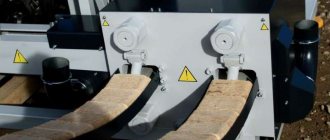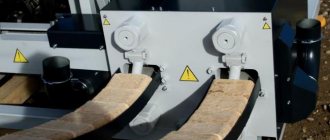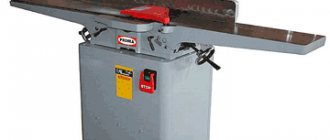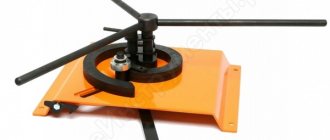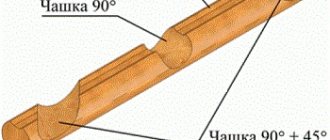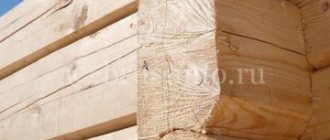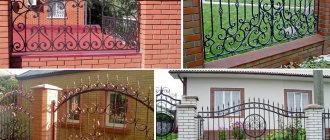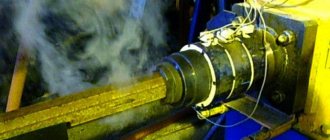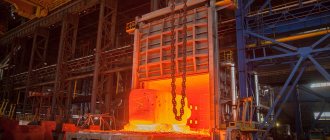When processing both sawdust and other types of wood waste, 3 types of equipment are used:
- shredders;
- dryers;
- press.
This equipment is used in most technological chains associated with the processing of any wood waste.
In this article we will talk about:
- device;
- cost;
- use
such equipment in various technological chains.
Shredders
Devices of this type process any wood waste into chips and sawdust of various sizes.
All devices of this type are divided according to the principle of their effect on wood:
- knife (rotary);
- drums;
- disk;
- hammer;
- shredders;
- combined.
Knife
Knife shredders are suitable for processing:
- thick branches;
- scraps;
- other waste whose length exceeds 20 cm.
Their base is a thick steel circle on which 3–6 knives are attached. The wood is fed at an angle to the disk , so the knives also cut it at an angle, forming chips.
The size of the chips depends on:
- disk rotation speed;
- feed speed;
- waste thickness.
The higher the disc rotation speed, the faster the knives pass through the wood and the thinner the chips are. The same dependence is on the feed speed - the faster you push the wood into the chopper, the thinner the chips will be at the exit.
Increasing the thickness of the waste leads to an increase in the size of the chips, so crooked logs and thick branches can be cut into large chips suitable for making oriented strand boards .
Drums
Drum shredders are suitable for any large wood waste, including:
- logs;
- thick branches.
The basis of the chopper is a drum on which 3–6 knives are attached. The wood enters the drum in a straight line , so the knives cut off the end part.
Because of this, sawdust obtained from a drum chopper cannot be used for the production of OSB or wood concrete , because chips of a different structure (cut along the fibers) are needed there.
Without additional processing, such chips are used for:
- mulching the garden;
- filling paths;
- heating;
- smoking;
- obtaining pyrolysis gas.
After additional grinding, which was carried out by a hammer crusher for sawdust, the wood chips can be used for:
- production of pellets and briquettes;
- biofuel production;
- obtaining cellulose.
To supply the material, a ribbed shaft connected to a gearbox is used. The spring presses this shaft against the wood , so the ribbed surface pushes branches and logs forward and prevents them from flying back.
Feeding wood into such a chopper manually is very dangerous , because a branch or log can fly out from a blow from the knife and injure the worker.
Disk
This type of shredder is used to produce large chips cut along the grain. Therefore, the chips obtained from such a grinder are used for the production of OSB .
It is also used for:
- heating;
- obtaining pyrolysis gas;
- smoking;
- any work in the garden.
The sawdust chopper consists of a shaft on which saw blades of the same size are mounted at small intervals. By adjusting the gap between the disks, the thickness of the chips is also changed.
Wood waste is fed at an angle. By changing the feed angle, the size of the chips is adjusted - the closer the angle is to 90º, the larger the chips will be .
Hammer
These devices first cut wood , because they have a blade chopper installed, and then crush the resulting wood chips, turning them into small sawdust.
Therefore they are used for:
- waste recycling;
- grinding large chips.
Finished small sawdust is used for the production of:
- wood concrete;
- biofuels;
- organic insulation;
- cellulose and glucose;
- pellets and briquettes.
The basis of the hammer grinder is narrow steel plates (fingers) that strike steel supports. When the engine spins the shaft of the unit, the fingers, under the influence of centrifugal force, rotate so as to move as far as possible from the shaft .
When sawdust or wood waste is inserted into the shredder, the shaft rotation speed decreases slightly . However, the fingers move at the same speed, so they hit the steel supports, crushing the sawdust that gets between them.
Crushed sawdust falls onto the sieve and is sifted out - small ones pass through the holes, and large ones are sucked in by turbulent air flows and they again end up between the fingers and supports.
Shredders
These devices are designed for processing dirty wood, that is:
- sleepers;
- scaffolding;
- boards with nails.
The chips after processing with a shredder are:
- poor quality;
- different sizes;
- partially wrinkled,
Therefore, a wood chipper of this type is used to produce wood chips, which, without grinding, are used only for heating.
If further processing is necessary, then the wood chips:
- soak so that the metal settles to the bottom;
- dried and crushed using hammer crushers.
Power plants
All models of shredders are produced in one of three options:
- with diesel engine;
- with a gasoline engine;
- with an electric motor.
A machine with a diesel engine is noticeably more expensive , because the cost of such a power unit is tens of times higher than the price of an electric motor.
The advantage of a diesel engine is that it can be used where there is no electrical network.
Gasoline engines are installed on inexpensive portable models with low performance. Their advantage is the low price of the motor, which is 2–3 times more expensive than an electric motor of the same power.
The advantage of an electric power plant is that the cost of electricity is tens of times less than diesel fuel. Therefore, when processing large volumes, the difference in the cost of energy resources is enormous.
In mounted shredders, the power plant is the engine of a tractor or heavy truck, and the energy is supplied through the power take-off shaft.
Platforms
Shredders of any type are produced in four versions:
- stationary;
- portable;
- based on a wheeled van;
- as an attachment for a tractor or heavy truck.
Stationary shredders are characterized by maximum power and productivity , so they are installed only in enterprises with a large daily volume of waste processing.
Such devices are equipped with three-phase electric motors, because using a diesel engine is unprofitable due to the large difference in cost:
- electricity;
- diesel fuel.
Portable devices:
- are relatively inexpensive;
- have minimal performance.
They are equipped with electric or gasoline engines. The weight of such devices is 50–80 kg, so 2–4 people are required to carry them .
They can also be transported to:
- trunk;
- body;
- trailer
Prices for popular models
In this table we have included the most popular models of various types of shredders.
| Model | Type | Plaftorma | engine's type | Power kW | m3/h wood chips | Chip size mm | Price thousand rubles | Website |
| Moby 200 | knife | wheel trailer | diesel | 22-50 | 8—15 | 7—10 | 850 | Rubmaster |
| MRG-250E | knife | stationary | electric motor | 45-55 | 7—20 | 5—40 (reg) | 530 | |
| MRG-250E | knife | tractor | tractor | 50-100 | 7—20 | 3—40 (reg) | 465 | |
| RBC-11 | combo | portable | electric motor | 11 | 3 | 10—40 | 290 | Dosagran |
| RB-30 | drum | stationary | electric motor | 45 | 10—15 | 25-35 | 1297 | |
| RB-750-4-11 | knife | portable | electric motor | 11 | 3 | 5—20 | from 130 | |
| DShK-600-2-x7.5-1 | shredder | stationary | electric motor | 15 | 1—8 | 30-100 | 1550 | |
| RB-700-LG-18.5 | hammer | portable | electric motor | 18,5 | 1,5 | 3—8 | from 130 | |
| ShchRM-2 | rotary | stationary | electric motor | 7,5 | 2—5 | 5—30 (reg) | 122 | SPI |
| SRUB-350 | knife | portable | electric motor | 7,5 | 2—7 | 5—40 | 81 | Infel |
| SRUB-600 | knife | stationary | electric motor | 22 | 5—15 | 5—40 | 81 |
Machines used for making briquettes
At modern dachas there is a lot of equipment that requires appropriate fuel for normal operation.
A question arose: is it possible to create briquettes from sawdust that can be used as fuel, for example, for a greenhouse?
You can find a lot of unnecessary materials at the dacha. It can be:
- sawdust;
- boards;
- wood remains;
- straw;
- branches;
- coal waste;
- dry leaves;
- cardboard;
- paper.
All these materials burn well, but to use them you need to grind them. To do this, you can use special machines, so-called shredders. You don’t need to make them yourself; special stores offer ready-made devices for sale.
For such work, a rotary machine is suitable, which, using knives, can grind plant material.
The cost of such a machine is affordable for any summer resident. This device is indispensable when it is necessary to obtain plant fertilizers.
This machine can also be used to produce fuel briquettes. However, this machine alone is not enough; you must have additional equipment.
Technological process
To make briquettes you will need clay and, of course, sawdust. They are mixed in a ratio of 10:1, water is added until the consistency of the solution becomes formative. It is very important that the clay evenly occupies the entire volume of sawdust. It is the main connecting element.
You can mix this mixture by hand, but if possible, you can use a construction mixer. He will do such work quickly and efficiently.
A variety of materials are suitable for forming briquettes:
- boxes;
- discarded pots;
- any container.
The best molding materials are boxes.
Such briquettes have a precise geometric shape and rectangular cross-section. In this form, they are easier to store, since storing them will not cause any difficulties. The formation of the future fuel should be carried out by pressing the finished solution.
The last operation of making briquettes is their drying. It's good when it's bright sunny weather outside. Briquettes dry very quickly.
To give strength to the briquettes, it is necessary to line the bottom of the molding box and its walls with paper before forming. Then pour in the prepared solution and press.
What kind of machine can you use to make briquettes?
Home craftsmen make such machines for making sawdust briquettes with their own hands. Briquettes are obtained in the form of bricks or round blanks.
Presses
Sawdust pressing is necessary for the production of various wood products, for example:
- pellet;
- briquettes;
- chipboards (chipboards);
- wood-fiber boards (fiberboard);
- oriented strand boards (OSB).
Despite the fact that a special press is used for each product, the general task is the same - creating pressure on the material in order to compress it and force it to take the desired shape.
Therefore, two types of presses are used to process wood waste:
- mechanical;
- hydraulic.
Mechanical
A mechanical press (granulator) is used in the production of pellets.
The principle of its operation is that the gear wheel, which creates pressure, moves along the matrix, unable to move away from it even a fraction of a millimeter.
The wheel presses the sawdust and shavings that have fallen under it to the matrix, the exit from which is only through tapering holes.
As a result of this compaction, pressure is created sufficient to release lignin from the wood , which glues together:
- sawdust;
- shavings.
Such a machine for pressing sawdust consists of a fixed frame on which are mounted:
- electric motor;
- gearbox;
- matrix;
- shaft.
Instead of an electric motor, small gasoline engines , similar to those installed on walk-behind tractors or chainsaws, are sometimes used. The gasoline engine allows you to create fuel pellets even where there is no electricity.
The gearbox performs the following functions:
- reduces the speed of rotation of the motor shaft;
- increases torque.
After all, in order to press sawdust and shavings, you need:
- high torque;
- low speed.
Shaft connects:
- gearbox;
- gear wheels,
which are attached to it using a cross shaft.
To produce fuel pellets in large volumes, granulators are used, in which gear wheels are fixed to a stationary frame, and a matrix made in the form of a ring rotates around them.
Hydraulic
To produce briquettes , a hydraulic press is used that compresses several matrices at once. The more matrices, the more powerful the press must be, because it is necessary to compress sawdust and shavings until lignin is released, which glues them together.
This press consists of:
- hydraulic pump;
- hydraulic cylinder;
- set of matrices.
The hydraulic pump operates from any electric or gasoline engine.
Also, for the production of briquettes, a press extruder is used , which is similar in principle to a granulator, but instead of gears, it has a screw installed, which presses the material into the hole of the matrix with great force.
operates in a similar way in a meat grinder , feeding the material under the knives and forcing it to pass through the holes of the matrix.
After the compressed material exits the die hole, it:
- cut to the required length;
- cool.
Drums
Another type of press that is used for the production of fuel briquettes is impact presses . In them, the material enters the matrix using a screw.
When the die is filled, the press hits it with a heavy metal punch. During the impact, a pressure of up to 2 tons per cm2 occurs , which is enough to release lignin and glue the wood together.
The output of such a press is the following briquettes:
- weight;
- size.
Complex lines
For the production of building boards (chipboard, fibreboard, OSB), a press is used as part of a complex line, because it is necessary to first lay the material in layers, then impregnate it with glue and only then compress it.
In addition, presses for the production of building boards not only compress, but also heat the material.
Therefore, for the production of building boards, a hydraulic press is used , which consists of:
- hydraulic pump;
- hydraulic cylinder;
- fixed flat plate;
- movable flat plate.
The hydraulic cylinder moves the upper plate and, pressing it against the lower plate, creates the necessary pressure. Steam is supplied to the upper and lower plates, which heats them and through them heats the material to be glued.
The hydraulic pump of such a press runs only on electricity , and the steam generator can be anything.
Price
Here is a table from which you will find out approximately how much a sawdust pressing machine with the ability to carry out various operations costs:
| Model name | Purpose | Equipment and description | Price (thousand rubles) | Manufacturer or seller website |
| Pelletizer 2/200 | Granulator | A granulator with a capacity of 100–150 kg/h can be equipped with a diesel engine, but this will increase its price | 114 | acontr.com |
| DG-1000-MX-L | Granulator | Granulator with a capacity of 1 t/h, with an electric three-phase motor | 1660 | doza-gran.com |
| BP-350 | Briquette extruder | Capacity up to 350 kg/h, electric three-phase motor | 440 | trade43.ru |
| GC-HBP-1000 | Briquette press | Capacity 1.2 t/h, adjustable briquette diameter, 45 kW electric motor | 5700 | eurasiagroup.tiu.ru |
| PBU-070-800 | Briquette Impact Press | Capacity 600 kg/h, three electric motors of different power | 2227 | machines-rks.rf |
| Chipboard production line | Fully equipped line, including all necessary equipment, including a press | Capacity up to 50 thousand m3/year, made in China | 18-144 million rubles | russian.alibaba.com |
Equipment for sawdust production. How to make sawdust
Sawdust is produced at wood processing plants as industrial waste. New technologies make it possible not only to burn them, poisoning the atmosphere, but to use them through recycling - for the manufacture of various materials necessary in everyday life and production. Sawdust can be produced using equipment specially designed for this purpose. It consists of several elements:
- A wood cutting machine that crushes wood into technical chips,
- Dispenser-storage (hopper),
- Chipper for wood chips.
Such equipment is quite simple and relatively inexpensive. To produce sawdust, you can use illiquid wood, which is not suitable for making furniture, building materials and veneer. You can use dead wood and fallen trees from the forest. This way you get cheap material and contribute to the purification of nature. To produce pressed sawdust, you need more complex and expensive equipment called a granulator line. It consists of the following elements:
- Chopper,
- Receiver hopper and dispenser,
- Dryers,
- Thermal generator,
- Cyclone type fan,
- Dry product bins,
- Machines for the production of briquettes.
Sales of sawdust can be carried out in several directions. Pressed sawdust is in great demand in construction, where it is used for the production of insulation materials. You can also make pressed sawdust for livestock farming, where it is used as livestock bedding, cat litter, and briquettes for smoking. Fuel briquettes are made from sawdust.
kudavlozitdengi.adne.info
Vacuum cleaners
When working on any processing or processing equipment, a lot of shavings and fine wood dust are produced, which both fly towards the operator and scatter around, littering the area. To protect the operator and avoid cluttering the area, it is necessary to install a ventilation system that works on the principle of a vacuum cleaner .
In large workshops, the role of a vacuum cleaner is played by
a rotary fan (centrifugal blower) of the snail type, connected to a cyclone type filter .
As the rotor rotates, it pushes air away from itself, so it escapes into the atmosphere through the outlet. A vacuum arises inside the cochlea, which flows first into the filter, then to each of the machines.
During operation of the ventilation system, the passing air carries away the flying chips, so that they do not fly towards the operator or around the machine, but through the air ducts enter the filter .
The design of the filter is such that lighter air rises and leaves through the hole located on top, while heavier chips settle on the walls and then fall to the bottom. When the filter is full, a truck or dump truck is placed under it and, opening the valve, the accumulated wood processing waste is poured out.
Vacuum cleaners are also used when working with small universal equipment, because even in it, chips fly in different directions.
The most effective systems are those consisting of a centrifugal blower and a Cyclone-type filter, but you can get by with a powerful household vacuum cleaner.
Many universal machines already have a ventilation system, so a source of vacuum , thanks to which the air passing through the unit will carry with it the processing waste.
Household vacuum cleaners are most effective when working with hand-held electrical equipment due to the fact that this tool produces a small amount of waste, and the vacuum cleaner's storage tank does not fill very quickly.
For more information about vacuum cleaners and the ventilation system used in wood processing, read this article (Vacuum Cleaner).
Here are some examples of exhaust equipment:
| Model | Brief description and characteristics | Cost of rubles | Seller or manufacturer website |
| Ancord VU-2000 | Complete system consisting of fan, cyclone filter and chip bags. Suitable for most carpentry machines, but can only serve a single unit. | 18000 | vacuum-press.ru |
| UVP-7000 | A fully equipped system consisting of a fan, several cyclone filters with bags for collecting chips. Suitable for most carpentry machines, thanks to its high power it can serve several machines. | 79000 | www.stanki.ru |
| Encore Corvette-60 | Low-power chip extractor equipped with a bag for collecting chips. Suitable for use with hand-held woodworking power tools. | 7000 | skbtools.ru |
The design is made on the basis of a hydraulic installation
Step-by-step instructions for making a press
- To make the base, you need to connect the parts from the channel by welding.
- Cut 4 pieces 1.5 m long from the corners (they are used as stands). Weld them to the base at the same distance from each other (vertical location).
- Fix a drum made from a large diameter pipe to the corners. If such a pipe is not at hand, you can make the mixer body from a sheet of tin. To increase productivity, it is equipped with an electric motor.
- A box for filling raw materials is made from sheet iron. It is recommended to make the body shape in the form of a cone for spontaneous loading movement when filling the trays.
- The gearbox is fixed to the bottom of the cone-shaped body and a tray for the output product is welded.
- In a thick-walled pipe, make holes at intervals of 3-5 mm. When pressure is applied to the mass, air and water will escape through the holes. Weld a flange to the bottom of the workpiece that will hold the removable bottom. The bottom is made of a sheet of steel in the form of a circle with eyes.
- Weld the matrix to the base under the cone-shaped body.
- Cut a disk from a steel sheet of a size that would allow free movement in the matrix. It performs the function of a punch.
- Weld the prepared pipe for the rod to the punch. The other edge is attached to the hydraulic unit.
- The assembled unit is mounted on racks directly above the matrix.
- The receiving tray is installed in such a way that it does not interfere with the process of shooting and fixing the matrix bottom.
Pre-drying will be provided by heating elements installed around the perimeter of the machine. The briquettes will be ready for final preparation in an open area with low air humidity.
According to the technological process, raw materials need to be prepared before processing, which means a dryer and a grinding device are required
Blitz tips
- When making a homemade screw extruder, you should use only high-quality steel.
- It will not be possible to reproduce the process of producing briquettes with the release of lignin using homemade equipment , so it is recommended to add clay, cheap wallpaper glue or corrugated cardboard to the crushed raw materials. These components will be used as a binder.
- The simplest and most affordable are considered to be self-made devices equipped with a manual screw drive. The perforated form is filled with prepared sawdust mixed with a binder. Forming is carried out by tightening a screw. Such a press has one significant drawback - low productivity.
- Some craftsmen use a hydraulic jack to assemble a home press. It is worth noting that such a device is not capable of creating a pressure of even 300 Bar. A small amount of water and a binder added to the crushed raw materials will help improve the quality of briquettes.
- Crushed sawdust is used for the press, so the equipment should be supplemented with a rotary machine , on which the raw materials can be prepared for pressing. You can also make a shredder yourself from an old washing machine. To do this, it is enough to install knives instead of the activator.
Do it yourself
The high cost of equipment does not always justify the cost of purchasing it, so craftsmen implement their designs to create homemade presses. It is worth noting that making a screw device is quite difficult, so not everyone undertakes this type of pressing.
At home, it is almost impossible to achieve the required level of pressure that would ensure the release of lignin. But it is quite possible to build hydraulic units and granulators with your own hands.
All homemade devices are divided into three main types:
- The sawdust briquetting technology itself is quite interesting and has its advantages, so owners do not deny themselves the desire to acquire a home press
from jacks;
- with manual drive;
- with hydraulic drive.
The sawdust briquetting technology itself is quite interesting and has its advantages, so owners do not deny themselves the desire to acquire a home press.
Thanks to the use of briquettes, it is possible to prevent the formation of debris near the firebox of a stove or boiler, as well as to eliminate frequent loading. The location of home-made units can be wall-mounted or floor-mounted, depending on how convenient it is for you.
Before you begin assembling the press, you need to take into account all stages of the production process to ensure drying and grinding of raw materials. It is also worth taking care of a utility room or shed for storing finished products.
To assemble a hydraulic press, you will need to prepare the following materials and tools:
- metal sheet 4-6 mm;
- corner 100x100 mm;
- channel;
- a pipe with thick walls (the diameter is determined by the size of the briquettes at the outlet);
- pipe 25-30 mm for making a punch rod;
- galvanized steel for forming trays;
- large pipe or sheet of metal for making the mixer body;
- welding machine and electrodes;
- grinder with discs;
- drill;
- hammer;
- measuring devices, etc.
